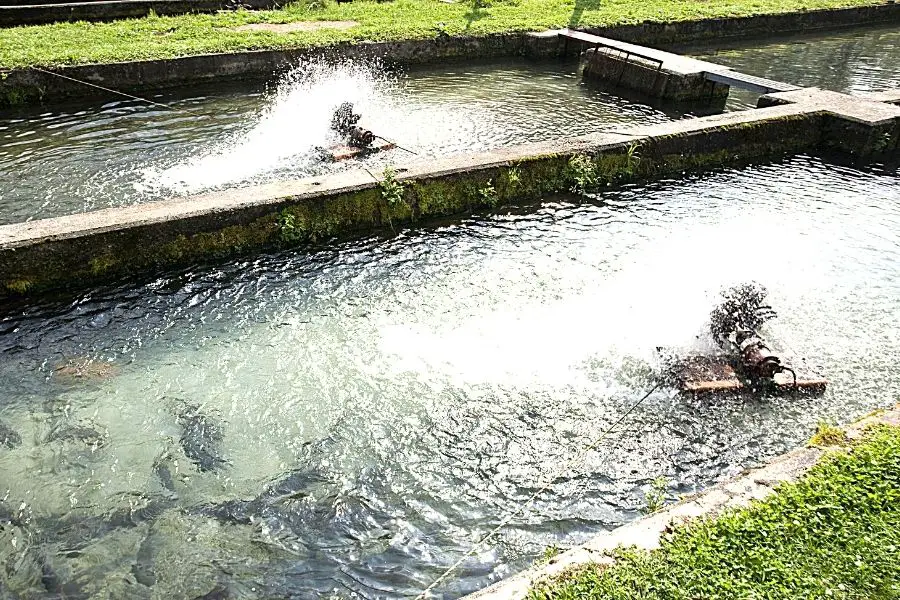The sun is one of the most important and necessary sources of renewable energy on the planet, and most living creatures require sunlight one way or another in order to be able to live and nourish themselves.
But do fish farms need sunlight?
Fish farms or ponds don't necessarily need sunlight. Still, they may benefit from it for various reasons like maintaining the stability of pond water, regulating water temperature, and promoting the appearance of water plants and plankton to provide food and oxygen for fishes, among other advantages.
For the purposes of this writing, we'll be delving into further details regarding the advantages that sunlight brings to fish farms in general, as well as other aspects worth considering.

What Are The Benefits Of Sunlight for Fish Farms?
People might get surprised by the fact that many fishes don't need sunlight to live. The deep sea is filled with creatures devoid of the life-giving sunbeams, yet they still manage to make it through.
If you're keen on fish farming, there is a vast amount of data that needs to be assessed to be able to run a fish farm, let alone start one. Depending on the type of fish farm that you own or operate, you'll have to be mindful of many variables, including the species of fish that are grown, the type of feed you supply to those fishes, and the size of the tank or pond.
For example, if you are providing artificial aeration, or, to put it another way, if you're pumping oxygen to the tank by artificial means, you can probably rest assured that fish will be able to survive, provided that it's fed correctly.
Nevertheless, you may still probably profit from the sun's rays due to the following reasons:
Plankton and Water Plant Development
Plankton thrives under sunlight, oxygen, and water. These comprise a wide array of organisms, including crustaceans, protozoans, algae, bacteria, and mollusks.
These organisms form the base for both marine and freshwater ecosystems. They're set up to supply oxygen for the bulk of the water mass and a source of food for many fishes. Some species classified as plankton, such as bacteria and fungi, are needed to break down dead organic matter and transform it into plant nutrients, improving the overall farm environment.
Aquatic plants also share oxygen and food supplying functions through photosynthesis and stem production respectively, while also providing flooring and bedding for algae and bacteria.
Suppose you have a manmade fish tank that sits under a shade or in indoor areas. In that case, you can probably make up for the absence of plankton and aquatic plants by aerating the tank and supplying the feed from outside sources. Nevertheless, having these conditions generated naturally in big tanks can be a big plus.
Also, keep in mind that an excess of phytoplankton could be detrimental to certain fish species such as salmon, as these microorganisms go through respiration (or reverse photosynthesis), with a potential to deplete oxygen levels in the water.
Pond Coloration
Although LED lights can probably make up for this, the absence of sunlight is likely to render a pond greyish and dark, subsequently affecting the yielding power and welfare of freshwater fish.
Admittedly, this color shift could occur as a result of excessive feeding or overstocking, but pond color is often linked to the proliferation (or lack thereof) of plankton and other water-based nutrients and is indicative of how healthy are farming conditions in general, according to the type of fish farmed.
Temperature Regulation
For catfish farming, water should stay mildly warm. The sun aids in this aspect. When water evaporates, the cold rainwater helps the pond stay in optimal temperatures. In the absence of sunlight, there's the danger that the water may get too cold and, as a result, catfish will struggle to regulate their body temperature, leading to health issues and even death.
Needless to say, warm water does not bode well for cold-water fish, and you could also risk overheating the pond, which will lead to a lower amount of oxygen in the water.
Indeed, artificial fish tanks and aquariums can implement this function by installing thermostatically-controlled hang-on or submersible heaters. Ponds, on the other hand, will mainly benefit from sunlight to provide this function, granted that the pond is not too shallow or too deep (the ideal depth for catfish would be around 4 feet.)
Water Sanitization and Vitamin D Supply
The UV rays from the sun are pathogen killers, which is excellent for keeping pathogen-causing illnesses at bay. Also, fish will most likely improve their condition, such as color, thanks to the naturally-occurring vitamin D from the sun, since they are prone to absorb it through their skin just as much as we do.
Should We Use A Shade For Our Fish Farm?
Now that we have seen the benefits of sunlight for fish, there are certain things to look out for when dealing with the ins and outs of running a fish farm.
For one, a shallow pond will definitely expose fish to experience sunburn, which, apart from being detrimental to their health, will also reduce their quality. We already mentioned the cons of overheated water and its effects on fish.
Also, keep in mind that, during a drought, you'll not be able to replenish water at optimal levels for fish survival. This can cause the heat energy to be unable to dissipate, resulting in the water overheating further.
Under these adverse conditions, it helps to use a shade to avoid these drawbacks. The shade can be improvised in many ways, such as planting plants or trees. The presence of aquatic plants will also help manage the amount of sunlight that penetrates through the water.
Finally, fish shelters should be positioned in strategic spots so that the fish may get under them when needed, or you could build some fish caves, which can also help!
Conclusion
To summarize, sunlight, while not ultimately needed, is undoubtedly beneficial for your fish farm. For the most part, it creates optimal conditions for fish development without the farmer resorting to artificial means while reducing maintenance costs. However, we must also know how much is too much and take the required measures to ensure these animals can find shelter against sunlight on demand.
Sources:
plankton | Definition, Characteristics, Types, Diet, Size, & Facts | Britannica
Function of Aquatic Plants | Lake County, IL
(PDF) Pond Coloration, Interpretation and Possible Measures of Rectification for sustainable Aquaculture practice
Is Sunlight Good For Your Pond Fish?
Aquarium Temperature Control | Tropical Fish Hobbyist Magazine
